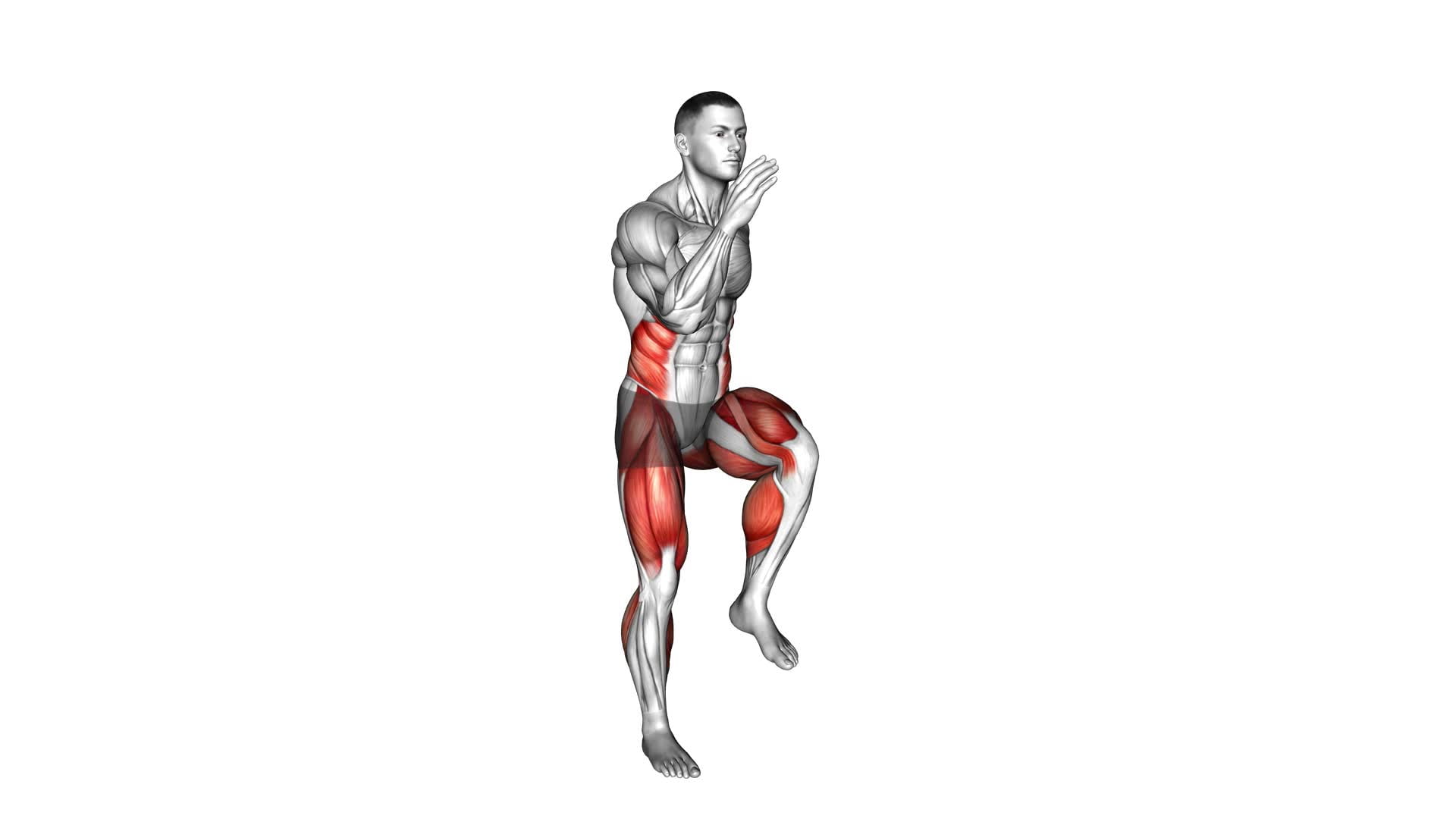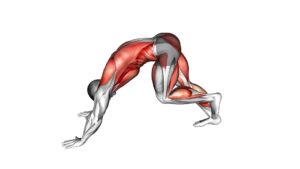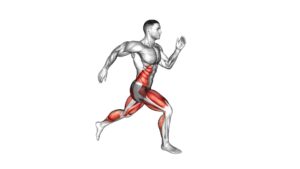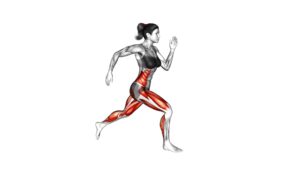Standing Sprint (male) – Video Exercise Guide & Tips

Are you looking for an intense workout that targets your lower body? Look no further than the standing sprint!
Watch This Exercise Video
In this video exercise guide, we'll show you the proper technique and form for the standing sprint, as well as variations and progressions to keep you challenged.
We'll also discuss common mistakes to avoid and share tips on maximizing the effectiveness of this dynamic exercise.
Get ready to feel the burn and take your fitness to the next level!
Key Takeaways
- Standing sprint targets lower body muscles such as quadriceps, hamstrings, and glutes.
- It improves cardiovascular health, endurance, leg strength, and power.
- Standing sprint enhances athletic performance and functionality.
- Incorporating variations and progressions can increase intensity and muscle engagement.
Benefits of Standing Sprint for Males
Experience the explosive power and cardiovascular benefits of the Standing Sprint, a high-intensity exercise that targets the lower body and provides a challenging workout for men. Incorporating this exercise into your routine can lead to improved cardiovascular health and increased leg strength.
The Standing Sprint is an excellent way to get your heart rate up and improve your cardiovascular health. By engaging large muscle groups in your lower body, such as your quadriceps, hamstrings, and glutes, this exercise increases your heart rate, improving your cardiovascular endurance over time. This can benefit not only your overall fitness but also your daily activities and sports performance.
In addition to cardiovascular benefits, the Standing Sprint is also effective in building leg strength. The explosive movements involved in this exercise require strong leg muscles to generate power and drive forward. By consistently performing the Standing Sprint, you can strengthen your lower body, including your thighs and calves, which can enhance your athletic performance and overall functionality.
Incorporating the Standing Sprint into your workout routine can provide you with a challenging and effective means of improving your cardiovascular health and increasing your leg strength. Remember to warm up properly before attempting this high-intensity exercise and consult with a fitness professional if you have any concerns or questions.
Proper Technique and Form for Standing Sprint
To perform the Standing Sprint with proper technique and form, follow these guidelines:
- Start in a standing position: Stand tall with your feet shoulder-width apart and your arms relaxed at your sides.
- Engage your core: Tighten your abdominal muscles to stabilize your body and maintain proper posture throughout the exercise.
- Drive your knees up: Lift your right knee towards your chest while simultaneously driving your left arm forward. Alternate the movement with your left knee and right arm.
- Pump your arms: As you drive your knees up, pump your opposite arm forward to generate momentum and increase speed.
Remember these key points to ensure proper technique and form during the Standing Sprint:
- Keep your chest up and your shoulders relaxed.
- Maintain a quick and light foot strike, landing on the balls of your feet.
- Focus on driving your knees up, rather than pushing off the ground with your feet.
- Keep your movements fluid and rhythmic, maintaining a steady pace throughout the exercise.
Variations and Progressions of Standing Sprint
Try incorporating different variations and progressions of the standing sprint to challenge and improve your speed and agility. By making modifications to the traditional standing sprint, you can target different muscle groups and enhance your overall performance.
One modification you can try is the single-leg standing sprint, where you perform the exercise on one leg at a time. This variation increases the demand on your stabilizing muscles and improves balance and coordination.
Another option is to incorporate resistance bands into your standing sprint workout routines. By attaching bands around your ankles or hips, you add resistance to the movement, forcing your muscles to work harder and increasing the intensity of the exercise.
Additionally, you can progress the standing sprint by incorporating explosive jumps at the end of each sprint. This plyometric variation helps to develop power and explosiveness in your lower body.
Remember to start with proper technique and gradually increase the difficulty level as you become more comfortable. As you explore different variations and progressions, be mindful of the common mistakes to avoid during standing sprint, which will be discussed in the next section.
Common Mistakes to Avoid During Standing Sprint
Avoid making these common mistakes during the standing sprint exercise to ensure that you can maximize your speed while avoiding injuries. Here are some key points to keep in mind:
- Improper foot placement: Make sure your feet are positioned correctly on the starting line. Placing your feet too far apart or too close together can affect your balance and decrease your speed.
- Bad posture: Maintain a tall, upright posture throughout the sprint. Leaning too far forward or backward can hinder your speed and put unnecessary strain on your muscles.
- Lack of explosive power: Remember to explode out of the starting position with maximum power. Failing to generate enough force can result in a slow start and hinder your overall speed.
- Neglecting warm-up: Always warm up before attempting the standing sprint. Proper warm-up exercises can help prevent muscle strains and other injuries, allowing you to perform at your best.
Tips for Maximizing the Effectiveness of Standing Sprint
To maximize the effectiveness of the standing sprint, consistently focus on explosive power and proper technique. One of the common misconceptions about standing sprints is that it's solely a lower body exercise. However, it's important to engage your entire body in order to generate maximum power and speed.
By driving your arms forward and back, you can generate more force and propel yourself forward. Additionally, make sure to maintain a strong core and engage your glutes and hamstrings to drive your legs explosively off the ground.
Incorporating standing sprints into a HIIT (High-Intensity Interval Training) workout can be a great way to boost your cardiovascular fitness and burn calories. To do so, start by warming up your body with some dynamic stretches and light cardio exercises. Then, choose a distance or time interval for your sprints, such as 30 seconds of sprinting followed by 30 seconds of rest. Repeat this cycle for a desired number of sets.
Remember to listen to your body and gradually increase the intensity and duration of your sprints as you build strength and endurance. It's important to maintain good form throughout the exercise to prevent injuries and maximize the effectiveness of your workout.
Frequently Asked Questions
How Long Should a Standing Sprint Workout Typically Last?
A standing sprint workout typically lasts around 10-15 minutes. It's a high-intensity exercise that offers numerous benefits, such as improving cardiovascular endurance, building leg muscles, and boosting overall fitness.
There are various variations of standing sprints, including hill sprints, sled pushes, and interval sprints. These variations help add variety to your workout routine and target different muscle groups.
Incorporating standing sprints into your fitness regimen can provide a challenging and effective workout.
Can Standing Sprints Help Improve Overall Speed and Agility?
Standing sprints can definitely help improve your overall speed and agility. They require explosive power and quick bursts of energy, which can translate to increased acceleration and faster reaction times. The standing position also allows for better muscle activation and engagement, targeting specific muscle groups used in sprinting.
When comparing standing sprints to running sprints, standing sprints have their own unique benefits. Incorporating standing sprints into your training routine can be a valuable addition to enhance your speed and agility.
Is It Necessary to Warm up Before Performing Standing Sprints?
Before performing standing sprints, it's necessary to warm up to prevent injuries and maximize your performance.
Warming up has numerous benefits, such as increasing blood flow, loosening your muscles, and improving your range of motion. It prepares your body for the intense activity ahead and reduces the likelihood of strains or pulls.
If you're looking for alternative exercises, consider lunges, high knees, or lateral shuffles to work on your speed and agility.
Are Standing Sprints Suitable for Individuals of All Fitness Levels?
Standing sprints can be modified to suit individuals of all fitness levels. Whether you're a beginner or advanced, there are ways to make this exercise work for you. Modifications can include adjusting the speed, intensity, or duration of the sprints.
The benefits of standing sprints vary depending on your fitness level. For beginners, it helps improve cardiovascular endurance and leg strength. For advanced individuals, it can be used as a high-intensity interval training to boost speed and power.
Can Standing Sprints Be Incorporated Into a Full-Body Workout Routine?
Yes, standing sprints can definitely be incorporated into a full-body workout routine. They offer a wide range of benefits, such as improving cardiovascular fitness, burning calories, and building leg strength.
There are also various variations of standing sprints that you can try, such as high knees, butt kicks, or lateral hops, to target different muscle groups and add variety to your routine.
Including standing sprints in your workouts is a great way to boost your overall fitness level.
Conclusion
In conclusion, the standing sprint is a highly effective exercise for males looking to improve their sprinting speed and power.
By using proper technique and form, variations and progressions can be incorporated to continuously challenge and improve performance.
It's important to avoid common mistakes and follow tips for maximizing the effectiveness of this exercise.
Incorporating standing sprints into your training routine can lead to significant improvements in overall sprinting ability.

Author
Years ago, the spark of my life’s passion ignited in my mind the moment I stepped into the local gym for the first time. The inaugural bead of perspiration, the initial endeavor, the very first surge of endorphins, and a sense of pride that washed over me post-workout marked the beginning of my deep-seated interest in strength sports, fitness, and sports nutrition. This very curiosity blossomed rapidly into a profound fascination, propelling me to earn a Master’s degree in Physical Education from the Academy of Physical Education in Krakow, followed by a Sports Manager diploma from the Jagiellonian University. My journey of growth led me to gain more specialized qualifications, such as being a certified personal trainer with a focus on sports dietetics, a lifeguard, and an instructor for wellness and corrective gymnastics. Theoretical knowledge paired seamlessly with practical experience, reinforcing my belief that the transformation of individuals under my guidance was also a reflection of my personal growth. This belief holds true even today. Each day, I strive to push the boundaries and explore new realms. These realms gently elevate me to greater heights. The unique combination of passion for my field and the continuous quest for growth fuels my drive to break new ground.







